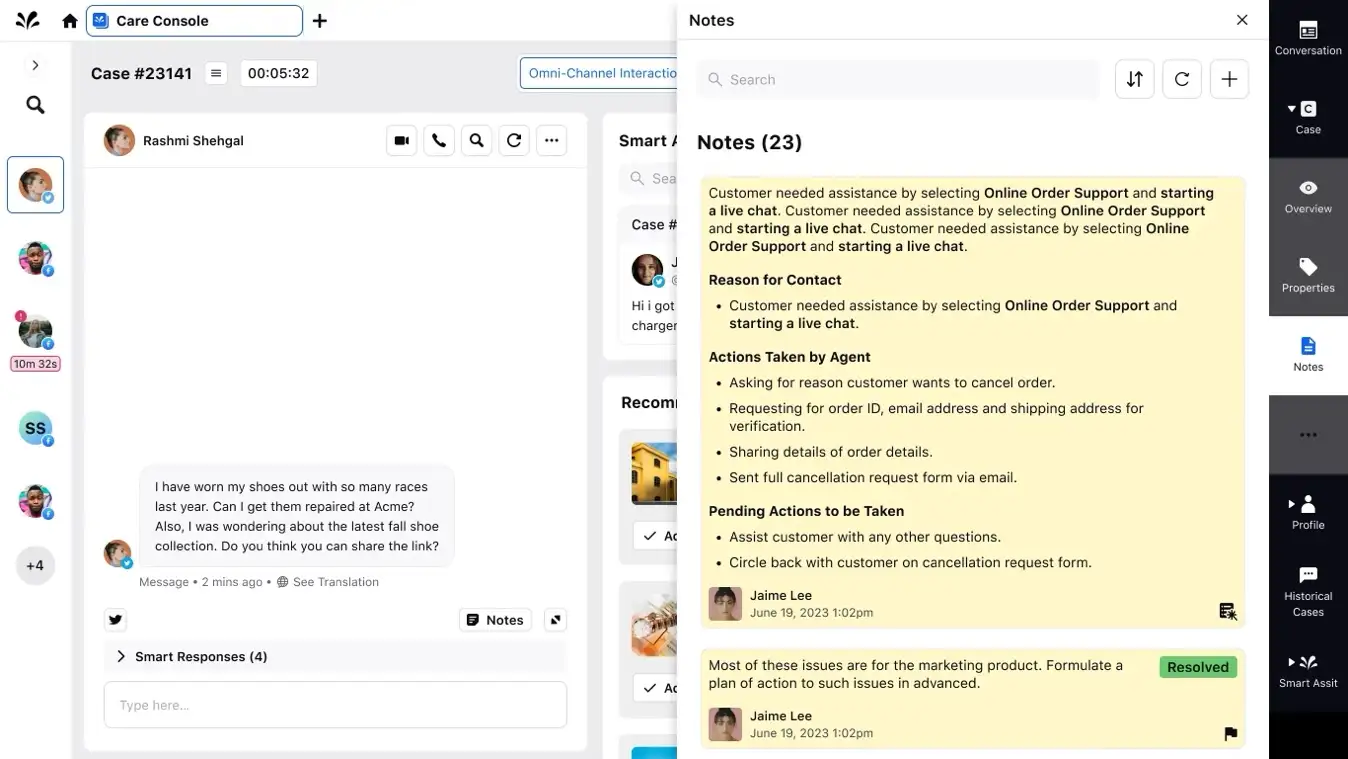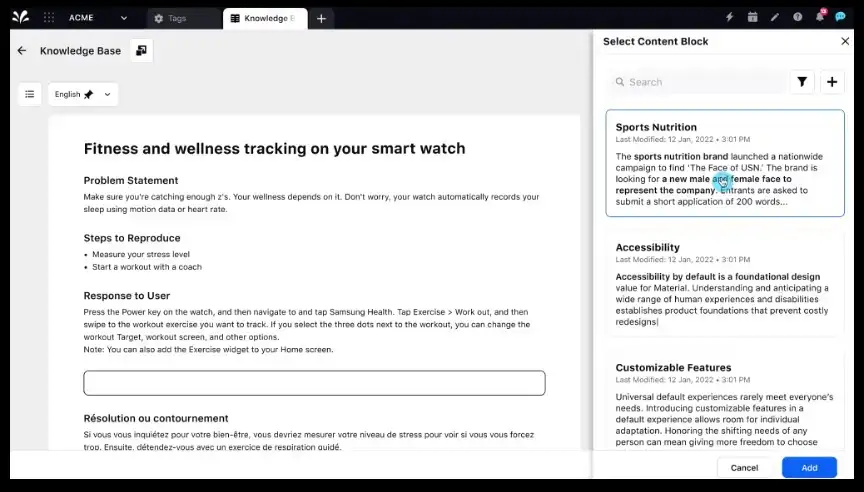The strategic AI-native platform for customer experience management
The strategic AI-native platform for customer experience management Unify your customer-facing functions — from marketing and sales to customer experience and service — on a customizable, scalable, and fully extensible AI-native platform.

Agentic AI in Customer Service: Your Next Advantage
Mounting customer expectations and economic headwinds are urging organizations to seek advanced solutions that can manage scale, maintain quality and free agents from repetitive workloads. One such solution is Agentic AI in customer service. These AI agents understand the broader customer journey, complete support tasks autonomously and escalate only when a personal touch is truly required.
In this article, we explore what sets Agentic AI-powered customer service apart from traditional automation and how it addresses today’s most pressing customer service challenges. It also covers real-world use cases and outlines the practical steps to be followed for successful enterprise adoption.
- What is agentic AI in customer service?
- How agentic AI in customer service helps teams work smarter, not harder
- Real-world use cases of agentic AI in customer service
- How agentic AI outpaces traditional automation in customer support
- Starting with agentic AI in customer service: Roadmap to real impact
- Ready to rethink customer service with agentic AI?
What is agentic AI in customer service?
In the context of customer service, Agentic AI refers to AI agents capable of independently managing complete service tasks, without relying on step-by-step instructions from human agents. These AI agents aren’t limited to following static scripts; instead, they act with autonomy, making informed decisions and taking actions that move a customer request toward resolution from start to finish.
In the customer service context, Agentic AI leverages real-time enterprise data and established guardrails to complete the assigned role and tasks with minimal human intervention. Let's understand with an example.
Example: A customer contacts support to update their billing address.
An AI agent can:
- Authenticate quickly by verifying login credentials, asking for an OTP, or matching stored account details.
- Guide the interaction by detecting missing information (e.g., postal code) and prompting the customer to fill gaps before submission.
- Execute the change by updating the address in the CRM or billing system and triggering notifications to other linked systems where integrations exist.
- Escalate when needed — for example, if the customer also mentions a recent missed invoice, the agent can route them to a human for account review instead of attempting a complex resolution themselves.
Still think agentic AI is just a smarter chatbot?
Think again. Traditional chatbots and rule-based automation often trap customers in rigid scripts, asking them to re-enter details, repeat information or switch channels before the issue is resolved. For something as simple as updating a billing address, this can mean multiple prompts, long delays and handoffs that waste time.
Agentic AI takes a different approach.
It maintains context across the conversation, gathers only the missing information and carries out the update directly in connected systems. If it detects related issues (like an undelivered statement tied to the old address), it can flag or resolve that proactively, without sending the customer in circles.
Now that we have established how agentic AI differs from traditional AI, let’s explore how it can be incorporated into customer service workflows to deliver better outcomes.
How agentic AI in customer service helps teams work smarter, not harder
With traditional automation often causing repetitive loops and customer frustration, organizations are now moving toward AI-led support workflows that help keep agents focused on critical, high-impact interactions and high-touch customer support.
Key applications of agentic AI include:
- Autonomous triaging based on case complexity, ensuring issues are prioritized correctly from the start
- Self-routing for refunds, product issues, or common inquiries, reducing manual ticket assignment
- Proactive agent assistance in live conversations, suggesting next steps or responses in real time
These capabilities translate into measurable operational improvements in the form of fewer escalations, shorter average handle times and stronger adherence to service-level agreements (SLAs), helping teams deliver faster, more accurate and more satisfying customer experiences. Let’s explore a few use cases to see how agentic AI drives real-world impact.
1. Automates resolution at scale without manual ticketing
Problem: Traditional support workflows often rely on manual ticket handling across multiple channels like email, chat, voice and social. This results in slower resolution times, repeated handoffs and higher costs per contact.
Solution: Agentic AI manages end-to-end workflows autonomously, from triage to resolution. It can classify tickets based on issue type and severity, resolve standard requests independently using pre-configured data and escalate only when human judgment is needed.
Impact:
- Reduces escalations and unnecessary agent intervention
- Lowers cost per contact by automating repetitive tasks
- Shortens time to resolution, improving SLA adherence
- Frees agents to focus on complex or high-value interactions
- Enhances customer satisfaction through faster, more accurate service
By managing interactions autonomously at scale, agentic AI enables enterprises to deliver faster, more efficient support while maintaining quality and reducing operational burden.
2. Improves agent productivity with intelligent task offloading
Problem: Agents spend a significant portion of their time handling repetitive requests, like password resets, basic billing inquiries, or order status checks, leaving little bandwidth for complex or high-empathy interactions.
Solution: Agentic AI autonomously handles these routine tasks, freeing agents to focus on revenue-impacting cases and interactions that require human judgment or empathy. The AI learns patterns, adapts to context and executes repetitive workflows without supervision.
Impact:
- Boosts operational efficiency by reducing manual workload
- Improves employee experience (EX) as agents spend time on meaningful, engaging work
- Accelerates response times and resolution for routine inquiries
- Allows teams to focus on high-value, customer-centric interactions
- Supports scalable growth without increasing headcount
Pro Tip: If you’re still on the fence about agentic investment, you can still keep your agent productivity and experience high by offering them a customer support platform with intelligent capabilities, such as:
- Real-time AI guidance: Provides agents with next best actions and contextual recommendations, helping them solve cases fast
- Automated after-call work: Generates case summaries and handover notes after every call, taking off this slog work from your agent’s plate
- Canned responses: Generates brand-compliant auto-responses for standard requests, saving tons of hours for your agents

Sprinklr comes loaded with all these capabilities and more to keep your team productive and engaged at all times. Request a demo today.
3. Delivers 24/7 support without growing headcount
Problem: Customers expect 24/7 support across multiple channels, but maintaining around-the-clock staffing is costly and often leads to inconsistent service quality during peak periods or unplanned surges.
Solution: Agentic AI delivers autonomous, always-on support, ensuring SLA compliance and minimizing wait times. It can handle incoming requests at any hour, across email, chat, voice and social, providing consistent and accurate responses even during traffic spikes.
Impact:
- Maintains SLA adherence and prevents ticket backlogs
- Reduces operational costs by limiting the need for additional staff
- Provides a consistent customer experience at all hours
- Enhances customer satisfaction with rapid, reliable support
- Enables teams to scale operations efficiently without sacrificing quality
There are many ways agentic AI can be applied to streamline customer service operations. Next, we’ll explore real-world use cases to see how organizations are putting it into action and driving measurable impact.
Real-world use cases of agentic AI in customer service
Businesses all over the world are searching for new ways to address growing customer service challenges. In this section, we’ll explore how leading enterprises have leveraged agentic AI to tackle these pain points and achieve measurable results in real-world operations.
Intelligent triage and contextual routing
Agentic AI leverages real-time metadata from incoming interactions, such as intent, sentiment and urgency, to ensure tickets reach the right team or agent quickly. Here’s how it works:
- Intent detection: Natural language processing (NLP) analyzes the content of the message or call to classify the type of request (e.g., refund, technical issue, product inquiry).
- Customer sentiment analysis: AI evaluates the customer’s tone and language to detect frustration, urgency, or satisfaction, flagging interactions that need priority attention.
- Urgency scoring: Based on SLA rules, transaction context and detected sentiment, the system assigns a priority score to each ticket.
- Dynamic routing: Tickets are automatically routed to the best-fit team or agent, factoring in expertise, availability and workload.
- Escalation triggers: If AI detects high-risk or sensitive cases, supervisors are immediately notified, and specialized workflows can be activated.
- Continuous feedback loop: AI learns from outcomes like successful resolutions, escalations or delays to refine routing decisions over time.
By combining intent, sentiment and urgency, agentic AI ensures that every inquiry is handled efficiently, response time is short and customer satisfaction is sky high, without human intervention.
After efficient routing, the next step is anticipating issues before they escalate, which brings us to proactive support agents.
Proactive issue resolution
Handling inquiries as they arrive is important, but preventing issues before they bother the customer takes service to the next level.
Agentic AI identifies potential problems by:
- Monitoring system alerts and transaction anomalies using real-time API integrations with ERP, OMS and CRM platforms to flag unusual orders, failed payments or stock inconsistencies
- Analyzing behavioral signals through machine learning models that detect repetitive actions, abnormal usage patterns or early indicators of churn
- Triggering automated preventive workflows, such as sending task-specific alerts to supervisors, adjusting inventory allocations, or routing high-risk transactions through validation checks before they affect the customer
With this approach, contact centers can intervene before customers notice issues, reducing escalations, improving satisfaction and maintaining smooth operations.
By resolving issues pre-emptively, agentic AI not only reduces inbound volume but also strengthens customer loyalty. With potential problems under control, the next focus is on handling high-volume transactional operations efficiently.
Fully automated order management, returns and account actions
Routine transactional requests like returns, cancellations or account updates can overwhelm agents and slow response times. Agentic AI integrates with ERP and OMS systems to handle these tasks autonomously, allowing teams to focus on higher-value interactions.
Because it works in real time, every update is instantly reflected across systems. No batch delays, no manual fixes.
Automated validation rules add another safeguard. The AI can:
- Cross-check customer identity before issuing a refund
- Apply region-specific tax rules
- Log every step for audit readiness
The result is fewer mismatched records, skipped steps or compliance gaps.
Efficiency gains show up fast. By removing “swivel chair” work, agents no longer waste time jumping between ERP, OMS, CRM and finance tools. Even tricky cases like partial returns or out-of-policy cancellations are handled through pre-built workflows, so resolution stays consistent at scale.
Once routine tasks are automated, it’s equally critical for agents to access accurate knowledge quickly to resolve complex inquiries efficiently.
Knowledge retrieval for faster, accurate responses
Did you know that nearly 8 in 10 Americans (78%) now turn to self-service portals, such as knowledge bases, to find the answers they need?
Even with efficient routing and automation, agents still need access to precise information to handle complex cases. Agentic AI comes armed with knowledge and insights from structured and unstructured enterprise data, including knowledge bases, past tickets and CRM logs, to provide accurate, real-time guidance.
Pro Tip: Empower customers to find answers faster by building a centralized, AI-powered knowledge base with Sprinklr’s Knowledge Base software. The platform makes it easy to create, organize and publish articles, FAQs and troubleshooting guides across web, mobile and chat, ensuring customers can self-serve wherever they are.
AI-driven suggestions surface the most relevant content, reducing search time and improving first-contact resolution. Analytics tools track which articles are performing best, helping teams continuously refine content and improve effectiveness. Lastly, keep information organized with categories, tags and smart search, so users and agents alike can find answers quickly and efficiently.

Keen to learn more? Request your demo today!
Also Read: 5 Real-World Agentic AI Use Cases for Enterprises
We’ve seen how agentic AI tackles real-world challenges and delivers results. Next, let’s explore where it truly goes beyond traditional automation.
How agentic AI outpaces traditional automation in customer support
As discussed, Agentic AI can surpass traditional automation in several key areas. Let’s compare their features side-by-side:
Feature | Rule-Based Bot | Agentic AI |
Handles escalation loops | No | Yes |
Adjusts actions mid-flow | No | Yes |
Learns from feedback | No | Yes |
Accesses multiple enterprise systems | Limited | Yes |
Resolves end-to-end issues | No | Yes |
Understands customer intent | Limited | Yes |
Provides proactive suggestions | No | Yes |
This expanded comparison shows how agentic AI goes far beyond traditional bots, offering autonomous, adaptive and continuously improving customer support.
If you’re comparing agentic AI to scripted bots — consider this:
A customer wants to change their shipping address, but hesitates mid-process. Would a rule-based bot know when to pause and reverify customer sentiment? Agentic AI, in contrast, does exactly that. It understands the context, adjusts actions on the fly and completes the update smoothly from start to finish.
Now that we are well-versed with how agentic AI has the upper hand on your traditional bot, it's time to learn how to implement it. Let’s get into it.
Starting with agentic AI in customer service: Roadmap to real impact
Implementing agentic AI doesn’t have to be overwhelming. Customer service leaders can follow this clear, three-step path to operationalize AI while maintaining control and quality:
- Identify high-volume, repeat tasks – Start with routine interactions like returns, order status inquiries, or account updates. These are ideal candidates for AI-led automation.
- Train on success and failure patterns – Feed the system historical cases to help it learn what works and where human intervention is needed.
- Layer in fallback logic and human validation – Ensure the AI knows when to escalate or hand off to an agent to maintain service quality.
A key checkpoint along the way is data readiness. Clean, structured data ensures the AI can recognize patterns accurately and act autonomously.
Worried about data dependencies?
Agentic AI can still operate effectively since it learns from patterns rather than relying solely on scripts. But messy or inconsistent data remains a real threat; it can still derail autonomy if not monitored and managed carefully.
Ready to rethink customer service with agentic AI?
If you’re rethinking customer service with agentic AI, Sprinklr’s AI Agents help you put the vision into practice. They enable:
- Seamless, context-aware conversations across channels
- Smarter task orchestration and routing
- Low-code setup with enterprise integrations
- Guardrails for compliance and brand voice
- Scalable automation that frees human agents for high-value work
It’s a way to deliver autonomy and efficiency without losing control or consistency.
Frequently Asked Questions
Agentic AI can handle a wide range of routine and transactional tasks, such as order status inquiries, returns, address updates, billing questions and simple troubleshooting. By analyzing patterns and context, it resolves these issues end-to-end without needing step-by-step human guidance
Yes, agentic AI operates within enterprise security frameworks, ensuring data privacy, access controls and regulatory compliance. It can enforce organizational policies while automating routine tasks, helping reduce errors and maintain governance standards.
Success is measured through operational metrics like reduced handle times, fewer escalations, higher first-contact resolution and improved SLA adherence. Customer satisfaction scores and agent productivity improvements also provide key indicators of effectiveness.
Agentic AI can operate autonomously for well-defined tasks, but human validation is recommended for complex, high-risk, or unusual cases. This hybrid approach ensures safety, accuracy and a smooth customer experience.
While chatbots follow predefined scripts, agentic AI adapts to context, makes decisions in real-time and resolves issues end-to-end. It complements chatbots and virtual agents by handling complex workflows that go beyond scripted interactions, delivering more intelligent and autonomous support.







